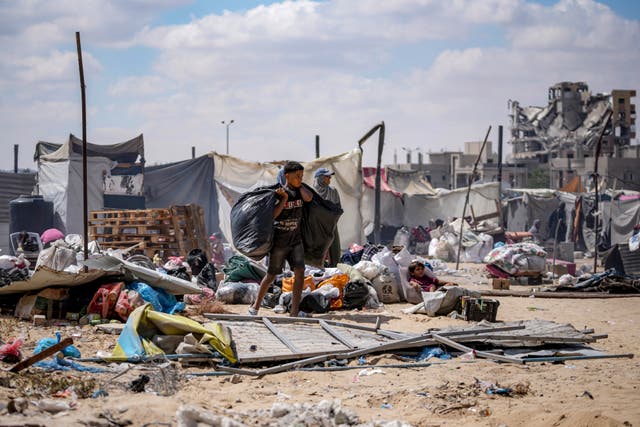More than 40,000 Palestinians have been killed in the Israel-Hamas war in Gaza, the territory’s health ministry has said.
Israel’s offensive has also wounded 92,401 people and displaced more than 85% of the population from their homes, the ministry in Hamas-run Gaza said.
It does not distinguish between civilians and militants in its toll.
The announcement came during yet another push from international mediators to broker a ceasefire in the war, now in its 11th month.
The conflict began on October 7 after Hamas-led militants attacked southern Israel, killing some 1,200 people — most of them civilians — and dragging roughly 250 hostages to Gaza.
Israel says 111 of the captives have not been released, including the bodies of 39. The hostages include 15 women and two children under the age of five.

In Gaza, health officials have struggled to fully identify the dead as bodies stream into overwhelmed hospitals and morgues where they say the count is compiled amid the chaos of war and displacement.
In its most recent detailed report on the dead, issued on Thursday, the ministry said 40,005 people have been killed.
Health officials and civil defence workers say the true toll is likely thousands higher, since many bodies remain buried under the rubble of buildings destroyed in airstrikes.
The update comes as international mediators are set to hold a new round of talks aimed at halting the war and securing the release of scores of hostages.
The US, Qatar and Egypt are to meet with an Israeli delegation in Qatar, although Hamas has not said whether it will participate, accusing Israel of adding new demands to an evolving proposal that had US and international support.
A ceasefire in Gaza would likely calm tensions across the region and may persuade Iran and Lebanon’s Hezbollah to refrain from retaliatory strikes on Israel after the killing of a top Hezbollah commander in an Israeli airstrike and of Hamas’ top political leader in an explosion in Iran’s capital.
The mediators have spent months trying to hammer out a three-phase plan in which Hamas would release scores of hostages captured in the October 7 attack that triggered the war in exchange for a lasting ceasefire, the withdrawal of Israeli forces from Gaza and the release of Palestinians imprisoned by Israel.
Both sides have agreed in principle to the plan, which President Joe Biden announced on May 31.
The air and ground offensive by Israel in Gaza has been one of the most devastating military campaigns in recent history.

Israel says it aims to eliminate Hamas and it blames Hamas for civilian deaths because militants operate in civilian areas and have built extensive tunnel networks underneath them.
Israeli forces have regularly targeted mosques, schools, hospitals and cemeteries where it claims fighters or tunnels are located, often causing civilian casualties.
The fighting has also killed 329 Israeli soldiers. The Israeli military claims around 15,000 Hamas fighters are among those killed in Gaza but has not provided evidence.
Nearly 85% of Gaza’s 2.3 million people have been driven from their homes, fleeing multiple times across the territory to escape ground offensives. During the war, thousands within Israel and in southern Lebanon have also been displaced.
The assault has created a massive humanitarian crisis in Gaza. The entire territory is at high risk of famine and more than 495,000 people — more than a fifth of the population — are expected to experience the most severe level of hunger in the next months, according to the latest report by the leading authority on measuring hunger.
Sanitation systems have been destroyed, leaving pools of sewage and towers of rubbish in tent camps packed with displaced families.
The offensive likely either damaged or destroyed 59% of all structures in Gaza by July 3, including 70% of buildings in north Gaza, according to an analysis of satellite data by Corey Scher and Jamon Van Den Hoek, experts in mapping damage during war.
The conflict has sparked fears of a wider regional war, with Lebanon’s Hezbollah and the Israeli military trading fire almost daily over their countries’ border.
More than 500 people have been killed on the Lebanese side, including some 350 Hezbollah members and 50 fighters from other militant groups, with the rest civilians. In Israel, 22 soldiers and 24 civilians have been killed.




Comments: Our rules
We want our comments to be a lively and valuable part of our community - a place where readers can debate and engage with the most important local issues. The ability to comment on our stories is a privilege, not a right, however, and that privilege may be withdrawn if it is abused or misused.
Please report any comments that break our rules.
Read the rules hereLast Updated:
Report this comment Cancel